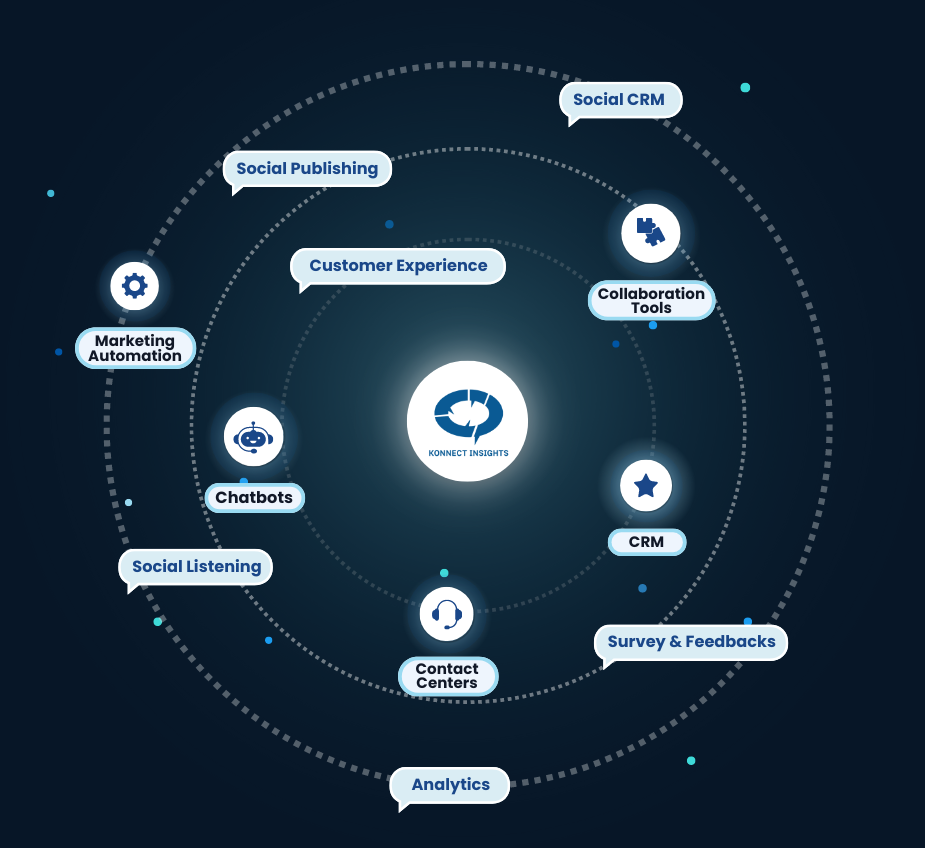In today’s digital age, schools face many of the same challenges as businesses regarding managing their online reputation and engaging with their community. Moreover, with the majority of students and parents being active on social media, schools need to have a strong social media presence and be able to monitor and respond to online conversations about their schools effectively.
Social media has become a powerful tool for achieving these goals. However, navigating the ever-changing landscape of social media platforms and staying on top of online conversations about your school can also be a challenge.
That’s where social listening comes in. By using social listening tools to monitor and analyze online conversations in real-time, schools can gain valuable insights into what their community is saying and how to improve their engagement. Social listening can also help schools detect and respond to potential crises before they escalate, protect their reputation, and build trust with their community.
In this whitepaper, we will explore the benefits of social listening for schools and provide practical tips and examples of how schools can use social listening to achieve their goals. Whether you’re looking to improve your school’s online reputation, engage with your community, or improve your crisis management, this whitepaper will provide valuable insights and actionable advice.
Understanding Social Listening for Schools
Social listening is the process of monitoring social media channels in real-time to detect and respond to online conversations about a particular topic or brand. For schools, social listening can be a powerful tool for managing their online reputation, engaging with their community, and improving their crisis management.
Schools can use many social media platforms for social listening, including Facebook, Twitter, Instagram, and LinkedIn. Each platform has its own unique features and user demographics, so schools need to understand how each platform is used and which platforms are most relevant to their audience.
When it comes to social listening in schools, there are several types of conversations that schools should monitor. These include discussions about the school, such as mentions of the school’s name or hashtags related to it. Schools should also monitor conversations about their industry or competitors, as well as conversations about relevant topics or trends.
By monitoring these types of conversations, schools can gain valuable insights into how their audience perceives them and what issues or concerns they may have. This information can help schools improve their online reputation and engage more effectively with their community.
Benefits of Social Listening for Schools
Social listening can provide a wide range of benefits for schools. From understanding the needs and preferences of students and parents to identifying opportunities for improvement, social listening can be a valuable tool for any school looking to enhance its digital presence and improve its overall performance.
In this section, we will explore some of the key advantages of social listening for schools and how they can help improve their online reputation, engage with their community, and respond to potential crises.
- Early detection of potential crises: By monitoring social media and other online platforms, schools can identify potential issues before they escalate into full-blown crises. This allows schools to address concerns and mitigate any negative impact.
- Improved communication with students, parents, and staff: With social listening systems in place, schools can better understand the needs and concerns of their stakeholders. Schools can improve communication and build stronger relationships by actively engaging with students, parents, and staff on social media and other online platforms.
- A better understanding of student needs and sentiments: Social listening can provide schools with valuable insights into student needs(such as student loan debt advice) and sentiments. By monitoring online conversations, schools can identify trends and patterns in student behavior and adjust their policies and programs accordingly.
- Identification of emerging trends and opportunities: Schools can stay up-to-date with the latest educational trends and developments by utilizing social listening. By monitoring online conversations, schools can identify new opportunities for growth and innovation.
Overall, social listening can help schools better understand their stakeholders, improve communication, and stay ahead of emerging trends and opportunities.
Read more: 20 Benefits Of Using Social Listening Tools For Your Business
Steps for Implementing a Social Listening System in Schools
Social listening can be valuable for schools to improve their online reputation, engage with their community, and detect and respond to potential crises. However, implementing a social listening system can seem overwhelming for schools that are new to the concept.
In this section, we will provide a step-by-step guide for schools to implement a social listening system:
- Setting goals for social listening
The initial step to implementing a social listening system is clearly defining the objectives. These goals may vary, ranging from identifying potential crises in their early stages to improving communication with students, parents, and staff, gaining better insight into student needs and feelings, or spotting emerging trends and opportunities. Defining clear goals helps schools select the appropriate social listening tools and strategies to accomplish their objectives effectively.
Selecting the appropriate social listening tools is the second step in implementing a social listening system. With a variety of tools available, each with its own benefits and drawbacks, schools must choose one that caters to their specific requirements while staying within their financial limits. Several widely used social listening tools include Hootsuite Insights, Brandwatch, and Sprout Social.
- Identifying relevant keywords and hashtags
After choosing a social listening tool, the next step for schools is to identify relevant keywords and hashtags. This involves determining the words and phrases that are commonly associated with the school, such as the school name, relevant topics or issues, or hashtags that are frequently used by stakeholders. By identifying these keywords and hashtags, schools can more effectively monitor social media channels for relevant conversations and mentions.
- Setting up alerts and notifications
Social listening tools typically offer the option to configure alerts and notifications, which can be triggered when specific keywords or hashtags are mentioned on social media platforms. This feature can assist schools in staying on top of any potential issues or concerns in real time, allowing them to respond promptly.
- Analyzing data and taking action
To wrap up the implementation of a social listening system, it is essential to analyze the data collected by the tool and take action accordingly. The data analysis will help identify trends, sentiments, and concerns from stakeholders. Based on the findings, schools can take action, such as addressing the concerns raised, adjusting policies and programs, or identifying opportunities to improve student engagement and satisfaction. It’s crucial to have a plan in place to act on the data to make the most of your social listening efforts.
Best Practices for Social Listening in Schools
It’s important to approach social listening with best practices in mind to maximize its benefits and avoid potential pitfalls. In this section, we will discuss the best practices for social listening in schools, including how to set up a social listening program, establish a protocol for responding to online conversations, and use social listening data to inform decision-making.
- Responding promptly and appropriately to conversations
Schools must keep track of their online reputation by monitoring social media and other digital platforms for any mentions of their school or relevant keywords. Once identified, schools should respond promptly and appropriately, addressing any concerns or issues raised by stakeholders.
This approach shows stakeholders that the school is actively engaged in the conversation and is dedicated to addressing their needs.
- Maintaining transparency and honesty in communications
Maintaining transparency and honesty in communications is crucial for schools when implementing a social listening program. It is vital for schools to clearly communicate with stakeholders about the purpose and benefits of the program.
This includes being transparent about how data is collected and used and any potential risks associated with the program. Schools should also allow stakeholders to opt out of the program if they do not wish to participate.
- Monitoring multiple channels and sources
Schools should monitor multiple channels and sources for relevant conversations to implement social listening effectively. This includes not only social media platforms but also blogs, forums, and news websites. Monitoring multiple channels can also help schools better understand the needs and sentiments of their stakeholders.
For example, they may discover that parents are discussing a particular issue on a parenting forum that they may not have mentioned on social media. By monitoring a range of channels, schools can ensure that they capture a broader range of feedback and insights from their stakeholders.
- Ensuring data privacy and security
This involves ensuring that data collection complies with relevant privacy laws and regulations. Schools must take appropriate steps to secure and protect this data, including implementing measures such as encryption, password protection, and access controls.
Additionally, schools must ensure that only authorized personnel have access to this data and that they are trained to handle it responsibly and securely. Any breaches or unauthorized access to data should be addressed promptly and transparently to maintain the trust of stakeholders.
- Training staff on social listening best practices
To ensure the effective implementation of the social listening system, schools should provide training to staff on social listening best practices. This training should cover various aspects, such as using social listening tools, identifying relevant keywords and hashtags, setting up alerts and notifications, and analyzing the collected data.
Moreover, staff should also be trained on how to respond appropriately to online conversations and address concerns or issues raised by stakeholders. By providing adequate training, schools can ensure that their staff is well-equipped to effectively use social listening tools and optimize the benefits of social listening programs.
Overall, by following these best practices, schools can ensure that their social listening program is effective, and responsible, and provides valuable insights into the needs and concerns of their stakeholders.
Challenges and Risks of Social Listening in Schools
While social listening can provide many benefits to schools, there are also challenges and risks that schools must consider when implementing a social listening system. These include potential legal and ethical issues, managing data privacy and security, and addressing negative feedback and criticism.
- Potential legal and ethical issues: Schools must ensure that their social listening program complies with all relevant laws and regulations, including those related to data privacy and protection. Additionally, schools must ensure that their social listening program is conducted ethically, respecting their stakeholders’ rights and privacy.
- Managing data privacy and security: Social listening involves collecting and analyzing large amounts of data from social media and other online platforms. Schools must ensure this data is collected, stored, and used securely and responsibly. This includes implementing appropriate security measures to protect against data breaches and unauthorized access.
- Addressing negative feedback and criticism: Social listening can provide schools with valuable insights into the needs and concerns of their stakeholders. However, it can also expose schools to negative feedback and criticism. Schools must have a plan in place to address negative feedback promptly and appropriately.
Overall, while there are challenges and risks associated with social listening in schools, these can be managed through careful planning and responsible implementation.
Conclusion
Social listening is an important tool for schools to monitor digital conversations and understand what stakeholders say about their school and the online education industry. While there are many benefits to social listening in schools, there are also challenges that schools must consider.
Despite the challenges, the benefits of social listening in schools are clear. Schools can better understand their stakeholders, improve communication, and stay ahead of emerging trends and opportunities by implementing a social listening program. We encourage all schools to consider implementing a social listening program to reap these benefits.
At Konnect Insights, we understand the importance of social listening in today’s digital age. Our omnichannel customer experience management suite offers businesses a unified solution to listen, evaluate, and improve customer experiences. With seamless integrations with over 3000 software applications and a range of features and tools, including social listening, social analytics, social publishing, surveys, and feedback, we make it easy for businesses of all sizes to improve their customer relationships and achieve their goals. Visit our website today to learn more!












